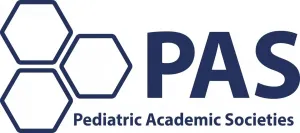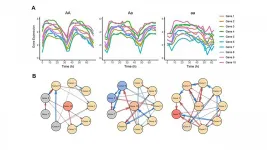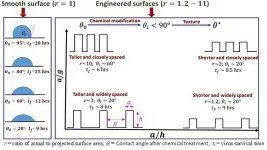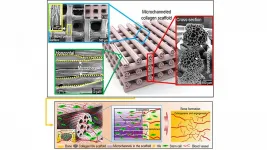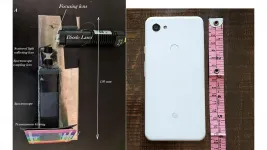(Press-News.org) Researchers at AMBER, the SFI Centre for Advanced Materials and BioEngineering Research, and from Trinity's School of Physics, have developed next-generation, graphene-based sensing technology using their innovative G-Putty material.
The team's printed sensors are 50 times more sensitive than the industry standard and outperform other comparable nano-enabled sensors in an important metric seen as a game-changer in the industry: flexibility.
Maximising sensitivity and flexibility without reducing performance makes the teams' technology an ideal candidate for the emerging areas of wearable electronics and medical diagnostic devices.
The team - led by Professor Jonathan Coleman from Trinity's School of Physics, one of the world's leading nanoscientists - demonstrated that they can produce a low-cost, printed, graphene nanocomposite strain sensor.
They developed a method to formulate G?putty?based inks that can be printed as a thin-film onto elastic substrates, including band-aids, and attached easily to the skin.
The team developed a method to formulate G?putty?based inks that can be printed as a thin-film onto elastic substrates, including band-aids, and attached easily to the skin.
Creating and testing inks of different viscosities (runniness) the team found that they could tailor G-Putty inks according to printing technology and application.
They published their results in the journal Small.
In medical settings, strain sensors are a highly valuable diagnostic tool used to measure changes in mechanical strain such as pulse rate, or the changes in a stroke victim's ability to swallow. A strain sensor works by detecting this mechanical change and converting it into a proportional electrical signal, thereby acting as mechanical-electrical converter.
While strain sensors are currently available on the market they are mostly made from metal foil that poses limitations in terms wearability, versatility, and sensitivity.
Professor Coleman said:
"My team and I have previously created nanocomposites of graphene with polymers like those found in rubberbands and silly putty. We have now turned G-putty, our highly malleable graphene blended silly putty, into an ink blend that has excellent mechanical and electrical properties. Our inks have the advantage that they can be turned into a working device using industrial printing methods, from screen printing, to aerosol and mechanical deposition.
"An additional benefit of our very low cost system is that we can control a variety of different parameters during the manufacturing process, which gives us the ability to tune the sensitivity of our material for specific applications calling for detection of really minute strains."
Current market trends in the global medical device market indicate that this research is well placed within the move to personalised, tuneable, wearable sensors that can easily be incorporated into clothing or worn on skin.
In 2020 the wearable medical device market was valued at USD $16 billion with expectations for significant growth particularly in remote patient monitoring devices and an increasing focus on fitness and lifestyle monitoring.
The team is ambitious in translating the scientific work into product. Dr Daniel O'Driscoll, Trinity's School of Physics, added:
"The development of these sensors represents a considerable step forward for the area of wearable diagnostic devices - devices which can be printed in custom patterns and comfortably mounted to a patient's skin to monitor a range of different biological processes.
"We're currently exploring applications to monitor real-time breathing and pulse, joint motion and gait, and early labour in pregnancy. Because our sensors combine high sensitivity, stability and a large sensing range with the ability to print bespoke patterns onto flexible, wearable substrates, we can tailor the sensor to the application. The methods used to produce these devices are low cost and easily scalable - essential criteria for producing a diagnostic device for wide scale use."
Professor Coleman was recently awarded a European Research Council Proof of Concept grant to build on these results to begin to develop a prototype for a commercial product. The ultimate aim of the group is identify potential investors and industry partners, and form a spin-out around the technology focusing on both recreational and medical applications.
INFORMATION:
A hot topic symposia session during the Pediatric Academic Societies (PAS) 2021 Virtual Meeting will address the persistent controversies and questions in preterm infant nutrition.
After six years of interdisciplinary expert discussion and critical evidence review, the 2014 vision to develop evidence-informed guidance for the nutritional care of preterm infants has come to fruition. The Eunice Kennedy Shriver National Institute of Child Health and Human Development (NICHD) and the Academy of Nutrition and Dietetics (AND) initiated this multiphase process involving expert physician, dietitian, and pharmacology scientists.
The first phase, Pre-B, addressed the existing evidence and research ...
WASHINGTON, May 4, 2021 -- How body clocks work could lead to science that can turn an early bird into a night owl or vice versa as well as other advances, like helping crops grow all year long.
In Applied Physics Reviews, by AIP Publishing, scientists at Penn State report on their work advancing knowledge about circadian rhythms, the natural process that governs sleep and waking patterns in humans, animals, and plants.
Researchers have identified a set of genes, called clock genes, that control these rhythms. But a more complicated network of genes than previously known appears related to circadian rhythms. More fully ...
WASHINGTON, May 4, 2021 -- If a respiratory droplet from a person infected with COVID-19 lands on a surface, it becomes a possible source of disease spread. This is known as the fomite route of disease spread, in which the aqueous phase of the respiratory droplet serves as a medium for virus survival.
The lifespan of the respiratory droplet dictates how likely a surface is to spread a virus. While 99.9% of the droplet's liquid content evaporates within a few minutes, a residual thin film that allows the virus to survive can be left behind.
This begs ...
What The Study Did: This survey study estimated change in the percentage of adolescents in the United States who reported at least one diagnosed concussion during their lifetime.
Authors: Phil Veliz, Ph.D., of the University of Michigan in Ann Arbor, is the corresponding author.
To access the embargoed study: Visit our For The Media website at this link https://media.jamanetwork.com/
(doi:10.1001/jama.2021.1538)
Editor's Note: The article includes funding/support disclosures. Please see the article for additional information, including other authors, author contributions and affiliations, ...
During our waking hours, the brain is receiving a near-constant influx of sensory signals of various strengths. For decades, scientists have wondered why some signals rise to the light of conscious awareness while other signals of a similar strength remain in the dark shadows of unconsciousness. What controls the gate that separates the shadows and the light?
In a new study from the Department of Anesthesiology and Center for Consciousness Science at Michigan Medicine, researchers identify a key area in the cortex that appears to be the gate of conscious awareness.
"Information processing in the brain ...
WASHINGTON, May 4, 2021 -- Spinal fusion is frequently performed to restore spinal stability in patients with spinal diseases, such as spinal stenosis, vertebral fractures, progressive deformities, and instability. In the past two decades, there has been marked increase in the number of people over 65 years in age who have needed spinal fusion surgery.
While autogenous bone grafts have long been considered the reference standard for spinal fusion, painful pseudoarthrosis remains a leading cause of poor clinical outcomes. Many researchers have consequently focused on ...
WASHINGTON, May 4, 2021 -- Scientists from Texas A&M have developed an extension to an ordinary cellphone that turns it into an instrument capable of detecting chemicals, drugs, biological molecules, and pathogens. The advance is reported in Reviews of Scientific Instruments, by AIP Publishing.
Modern cellphones include high-quality cameras capable of detecting low levels of light and eliminating digital noise through software processing of the captured images. Recent work has taken advantage of this sensitivity to produce cellphone cameras that ...
SAN ANTONIO (May 4, 2021) - Risk-reducing mastectomy saves lives of women who, because of hereditary or other risk factors, may have a very high lifetime risk of developing breast cancer, according to two new journal articles written to guide physicians and patients. All of these women should also discuss with their physicians nonsurgical options such as screening and medications to reach the best, customized treatment strategy, the essays mention.
Both articles, published May 4 in the Journal of the American Medical Association (JAMA), are by END ...
WHO Benjamin Rome, MD, Instructor of Medicine at Harvard Medical School and researcher in the Program On Regulation, Therapeutics, And Law (PORTAL) in the Division of Pharmacoepidemiology and Pharmacoeconomics, Brigham and Women's Hospital; corresponding author of a paper published in JAMA Network Open.
WHAT When drug manufacturers raise the list price for brand-name prescription drugs, do patients' out-of-pocket costs rise too? A new study published in JAMA Network Open by Dr. Benjamin Rome and colleagues in the Brigham's Division of Pharmacoepidemiology and Pharmacoeconomics finds that more than half of patients may experience increases in out-of-pocket spending when drug ...
BOSTON - Researchers from Massachusetts General Hospital (MGH) appear to have solved the 120-year-old mystery surrounding the failing health of famed Antarctic explorer Sir Ernest Shackleton over the course of his daring expeditions to Antarctica in the early part of the twentieth century. In a paper published online in the END ...
